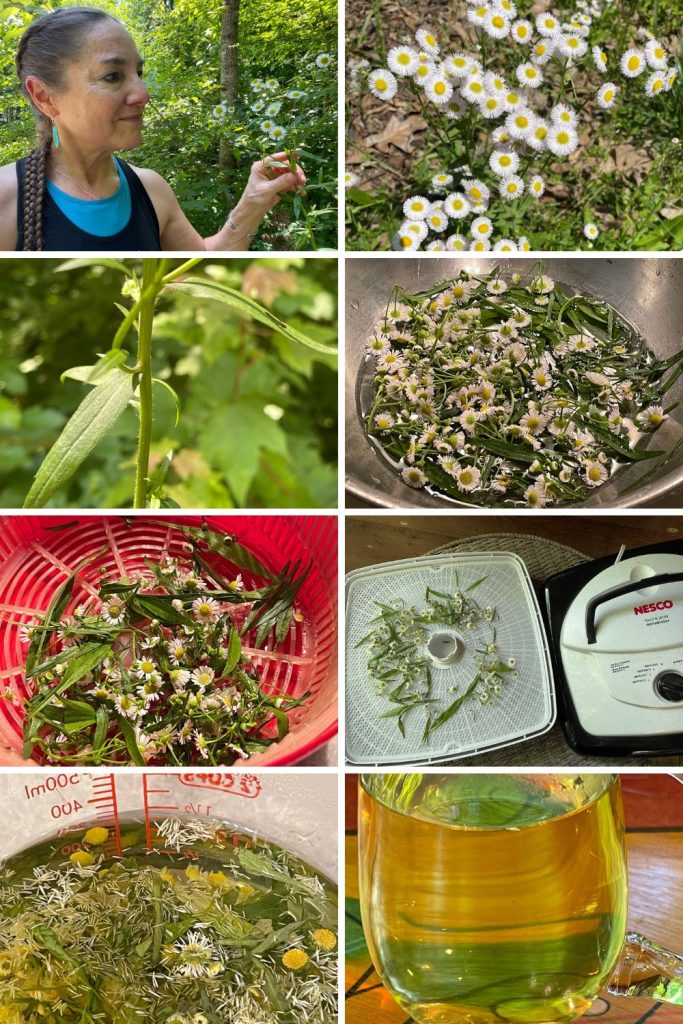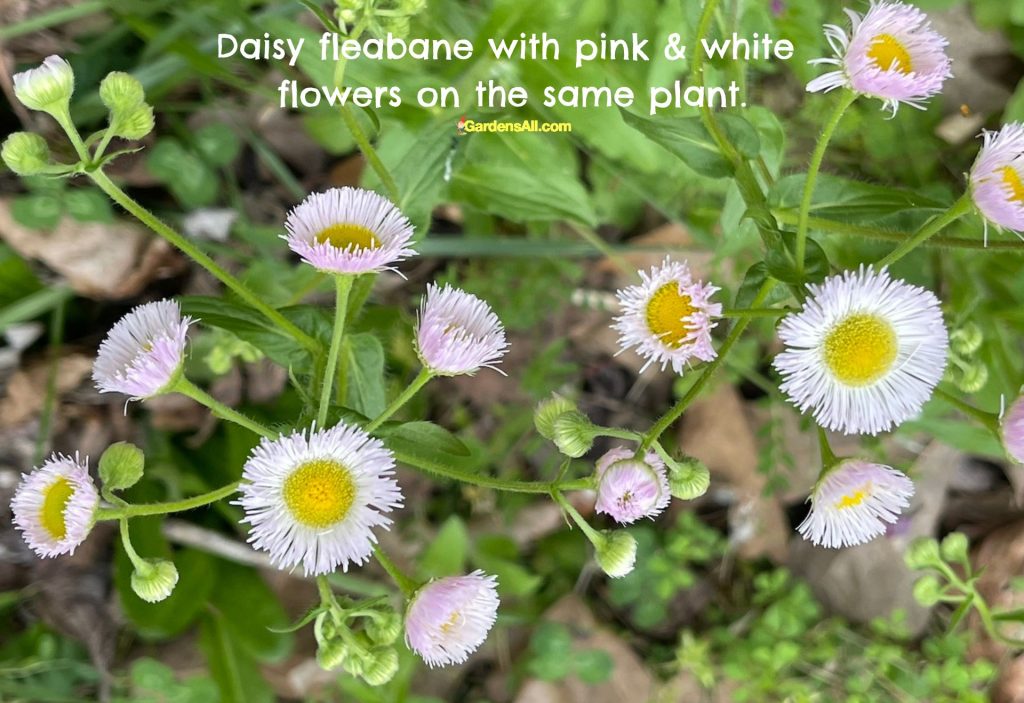A Tiny Pink or White Flower With a Yellow Center
That perky white wildflower with a yellow center that looks like miniature daisies or chamomile, might be daisy fleabane. But some of them are pink flowers with a yellow center, (Erigeron philadelphicus). Others varieties have beautiful purple flowers.
Eastern or annual daisy fleabane – (Erigeron annuus), is an early spring wildflower in North America. You’ll see daisy fleabane, in fields, roadside and drainage ditches. Fleabane grows best in full sun and alkaline clay soil, and can bloom spring through summer.
We see it on our walks on the roadside of our subdivision. It grows in tall stands of delightful clusters of low to medium tall stand of leggy stems with green leaves, and white flowers with yellow centers.
Fleabane especially enjoys growing in the lower, more moist sections of the drainage areas. However, in spite of the delicate appearing white flower, fleabane—like most weeds—is a sturdy and determined plant and can also tolerate dryer fields.
This year, where the white daisy fleabane were growing, we’re seeing pink and white flowers on the same plant!

A Note on Purple – “Wild Fleabane”
In some areas, daisy fleabane flowers are lavender or purple. These are called wild fleabane, Erigeron purpuratus.
Until this year, we’ve seen only the white flowers with yellow centers in our area of the northeast. But this year we had pink daisy fleabane, Erigeron philadelphicus, growing in the usual fleabane patches.

We’d love to see this in our fields, so we’ll be on the lookout for this lovely variety of fleabane, which should have the same benefits as the white fleabane, Erigeron annuus.

Is Daisy Fleabane (Erigeron annuus) Edible?
Yes! Fleabane leaves and flowers are edible and medicinal. While fleabane leaves are smooth, the stems can have a hairy texture that most people aren’t fond of in their foods, but which is reduced or eliminated in cooking.
Alternately, you can pluck the leaves and blossoms and omit the stems, or steam, sauté or cook them in soup as you would other cookable greens. To enjoy fleabane leaves raw, you can toss a few leaves into a salad with a blossom or two for garnish.
Is Fleabane a Beneficial Plant?
Yes! Daisy fleabane leaf extracts contain caffeic acid which is a stimulant and active compound that has protective and antioxidative benefits to cells. In addition, the flowers have been used in native healing traditions, while research has proven healing benefits of fleabane leaves and roots.[1]https://www.ncbi.nlm.nih.gov/pmc/articles/PMC6562390/[2]https://www.ncbi.nlm.nih.gov/pmc/articles/PMC3595701/

What Parts of Fleabane (Erigeron annuus) are Used?
- Leaves – Leaf water or extract is a beneficial antioxidant and improves obesity related diabetes[3]https://www.ncbi.nlm.nih.gov/pmc/articles/PMC6562390/
- Root – Extract of Erigeron annuus root is anti-inflammatory[4]https://www.ncbi.nlm.nih.gov/pmc/articles/PMC3595701/
- Flowers – Reduction of mucous
Daisy Fleabane, (Erigeron annuus) – all parts are beneficial: leaves, roots and flowers.

Is Daisy Fleabane Poisonous or Toxic?
Daisy fleabane can be mildly toxic to dogs and cats who consume parts of the plant. Fleabane can also cause skin rash[5]https://wagwalking.com/condition/fleabane-poisoning if sensitive skin comes in contact with the milky sap.
Humans with sensitive skin may also have skin reactions from contact with daisy fleabane. While not typically considered poisonous, if you or your pet has a strong reaction, seek medical assistance immediately.
Find more on plants poisonous to dogs here.
How is Fleabane Used
All parts of the fleabane plant are used, but the leaves and flowers are most active.[6]https://naturalpath.net/williamson/herb-of-the-day-eastern-daisy-fleabane/
Tea – Leaves, Roots and Flowers
Typically, only the flowers and leaves of fleabane (Erigeron annus), are used, however, you can also use the fleabane root for tea, either alone or with the flowers and/or leaves.[7]https://plants.usda.gov/DocumentLibrary/plantguide/pdf/cs_erph.pdf
Collect flowers and leaves while the plant is in bloom, then dry. Use your favorite drying method. The roots may also be collected at the same time but they will likely be more potent when the plant is no longer flowering.
This herb is light enough to be able to air dry, likely overnight. We used a dehydrator, and they’re ready the same day or overnight. Store dried flowers and leaves in a container with tight lid.

Tinctures – Leaves, Flowers
“An alcohol and water tincture extracts the medicinal phytochemical compounds better than a tea, which loses the oil soluble compounds that are the most active.”
~NaturalPath.net[8]https://naturalpath.net/williamson/herb-of-the-day-eastern-daisy-fleabane/
What is a Tincture?
Tinctures are concentrated herbal extracts of fresh or dried roots, bark, stems, leaves, flowers, seeds, and/or berries, that have that have been steeped (usually) in an alcohol solvent, typically vodka or brandy for 2-6 weeks. These are most often consumed directly by dropper or diluted in beverages, water or foods.
All tinctures are extracts, but not all extracts are tinctures!
~Mountain Rose Herbs
Extracts – Roots, Leaves
- Root extract can reduce inflammation
- Leaf extract has antioxidant properties and may also benefit Alzheimer’s
What is an extract?
Extracts use non-alcohol based solvents such as vinegar, glycerine, or water.[9]https://blog.mountainroseherbs.com/how-to-make-herbal-vinegar
We found just one brand of daisy fleabane extract on Amazon and it’s blended with cinnamon, but if you have access to Erigeron annuus, it’s super easy to make your own.
Essential Oils
- Anticancerous
- Antifungal
For their to be so much research citing the benefits of Erigeron annuus, it’s surprising that there are not more commercially available products out there for it. However, it may have to do with the volatility of the fleabane oil and how it loses potency, especially when dried for teas or powders.
Find more antifungal herbs here.
SOURCE: Mountain Rose Herbs[10]https://blog.mountainroseherbs.com/guide-tinctures-extracts

Best Jars for Herbal Extracts and Dispenser Bottles
Many people just use their 16-32 oz mason jars for steeping. However, we tend to make smaller batches of the seldom used tinctures. For example, our lemon balm tincture only gets used maybe a couple times a month as a sleep aid, so a small batch can last the year.
It’s advisable to fill up the jar halfway with loosely packed herbs, but all the way with the solvent medium (e.g., alcohol or vinegar). You want to keep the brew from corroding metal lids, so we go for jars with plastic lids like these smaller 4 oz glass jars with plastic lids for small amounts of herbal concoctions.
These are also a good size for doubling as a container for lotions and salves, so we like that you can buy a batch that can do double duty. But if you have lots of mason jars, use them but just place a protective layer over your brew, such as parchment paper of a plastic wrap or zip bag before you screw on the lid. Alternately, you can get a bundle of plastic mason jar lids.
Dropper Bottles for Herbal Extracts
For extracts we use less often or herbs we have less of, we like 2 oz sized dropper bottles, so one of the 4 oz steeper jars will fill two of the 2 oz dropper bottles.
For herbal extracts we use more often or herbs that we have lots to preserve, we like the larger jars and 4 oz dropper bottles. We also dehydrate most herbs to use for teas or powders throughout the winter.
Fleabane, (Erigeron Annuus) water extract may be useful as an effective natural product to prevent free radicals, obesity and obesity-related metabolic syndrome.
~2019 Fleabane (Erigeron Annuus) Study[11]https://www.ncbi.nlm.nih.gov/pmc/articles/PMC6562390/

Traditional Fleabane Uses by Native American Tribes
Several native American tribes used this plant.
- Lakotas:
- tea for children, to aid with sore mouths
- tea for adults with urination issues
- Navajo:
- used the plant to make lotions for headaches and body pains
- Mesquakies:
- made powder from the dried flowers for a snuff for head colds or to dry up mucous conditions
- Cherokee:
- infused the root for use in:
- coughs
- colds
- menstrual issues
- bad vision
- hemorrhaging
- kidney problems
- epilepsy
- gout
- female healing following a miscarriage
- infused the root for use in:
- Ojibwa:
- used it for tuberculosis
- reduce or eliminate hemorrhaging
- Blackfeet:
- diarrhea and dysentery
- Catawba:
- used it for cardiovascular issues
- Cheyenne
- boiled the plant in water and inhaled the steam for head colds and respiratory complaints.
- Other tribes used fleabane for:
- stomach issues
- intestinal parasites
- rheumatism
- lameness
- insect repellant
- boil for a sweat lodge inhalant
- burn for natural insect repellant
- blossoms were mixed with brains, buffalo spleen and gall for hide tanning
- plant dye
- friction fires (the stalk) referred by some tribes as ‘fire-maker’.
- Mexicans
- used fleabane for toothaches and to make tooth powder
- Early settlers
- stuffed their mattresses with fleabane and hung clusters in the homes to drive away fleas, hence the name, however other sources claim it doesn’t work for fleas.
Earlier Centuries Use of Fleabane
Dr. Nicholas Culpeper, English botanist, herbalist, physician, astrologer, 1616-1654
Culpeper refers to this plant in his writings as well. He said the English call it ‘mullet’ and that it is a hot and dry plant. He states that,
“The herb being spread under foot and smoked in any place, will drive away venomous creatures and will kill and destroy fleas and gnats. An ointment of the root and leaves is used with success for the itch.”
Benefits of Fleabane
Fleabane’s Medicinal Benefits Include
- Antimicrobial – leaves, root
- Antioxidant – quercetin, thymol and kaempferol
- Diuretic [12]https://www.henriettes-herb.com/eclectic/kings/erigeron.html
- Astringent – leaves
- Respiratory – flowers
- Congested cough – flowers
- Digestion
- Diarrhea
- Diabetes
- Loss of appetite
- Kidneys and Bladder
- Menstrual problems
- Obesity
- Postpartum bleeding
- Hemorrhage
- Kidney stimulant
Caffeic Acid Benefits –
Fleabane contains caffeic acid, which is beneficial for:
- Diabetes
- Obesity
- Supplements
- Inflammation
- Safe, even in large doses
- Inhibits cancer growth
- breast cancer
- colon cancer
- oral cancer cells
- Antioxidant used in skin and body care products
REFERENCES:
- Eclectic School of Herbal Medicine[13]https://eclecticschoolofherbalmedicine.com/fleabane-monograph/
- Medical News Today; 2019 Study [14]https://www.medicalnewstoday.com/articles/319510.php
- The Herb Hound[15]http://theherbhound.blogspot.com/2016/09/fleabane.html
- King’s American Dispensory, 1898[16]https://www.henriettes-herb.com/eclectic/kings/erigeron.html
- Dr. Nicholas Culpeper
- The Oil Shop[17]http://www.theoilshop.com/erigeron-fleabane-essential-oil
WARNING: Do not take during pregnancy or if allergic to ragweed, daisies, and related plants. This information cannot be construed as medical advice. Always seek appropriate and direct guidance from trained practitioners.

Fleabane Botanical Classification
Scientific name: Erigeron annuus
Higher classification: Daisy family
Genus and Species: Erigeron canadensis
Subfamily: asteroideae
Family: asteraceae
Common Names for Daisy Fleabane, (Erigeron annuus)
- Horseweeds
- Eastern Daisy Fleabane
- Canadian fleabane
- Fleabane daisy
- Colt’s tail
- Butter weed
- Fireweed
- Blood-stanch
- Cow’s tail
- Bitter weed
The USDA Forestry Service cites 390 known species of fleabane worldwide and about 173 species in North America. Similar plants to daisy fleabane – Erigeron annuus is Erigeron philadelphicus[18]https://www.fs.fed.us/wildflowers/plant-of-the-week/erigeron_lanatus.shtml[19]https://www.ediblewildfood.com/daisy-fleabane.aspx
REFERENCE:
USDA Forestry Service[20]https://www.fs.fed.us/wildflowers/plant-of-the-week/erigeron_lanatus.shtml
EdibleWildfood.com[21]https://www.ediblewildfood.com/daisy-fleabane.aspx
You may also enjoy our article on Calico aster, a fall-blooming wildflower in mid-zone 7a.


Wishing you the best health and wellness!
I’m LeAura Alderson, a garden, herb and plant enthusiast with a passion for discovering the many edible and medicinal benefits of the plants all around us, including the weeds! I’m a writer, editor and media publisher for our family of websites.
While I was certified in fitness and life coaching, I am NOT a health practitioner. However, I’m a lifelong health enthusiast, with a keen interest in healthy, organic foods and making home remedies and the content we share is from our own experience and usage as well as that extracted from scientific research so that you can explore further on your own.
Always seek the advice and guidance of your health practitioners first and foremost.
As a family we’re steadily expanding our gardening, experimentation and knowledge around all things gardening, edible landscaping, fresh organic foods and self sustainability with farming in our future. I also own and manage iCreateDaily.com, a site all about transformation through creation, and the power of positivity, optimism and mindset.
References

